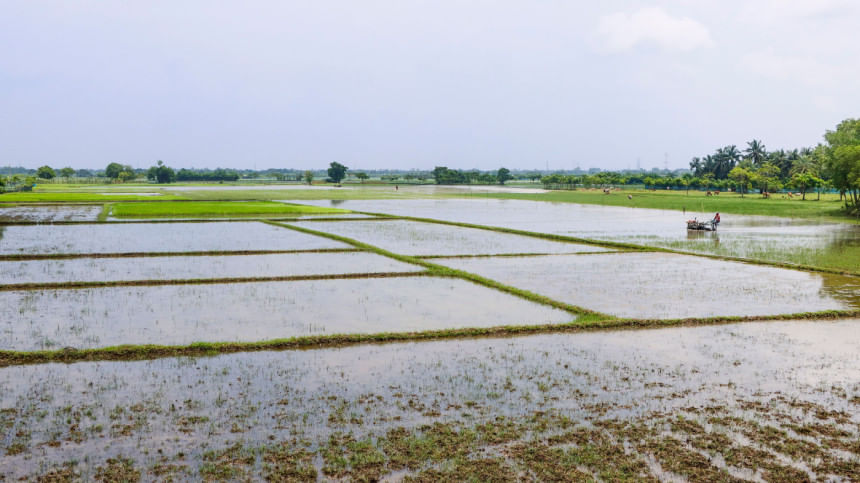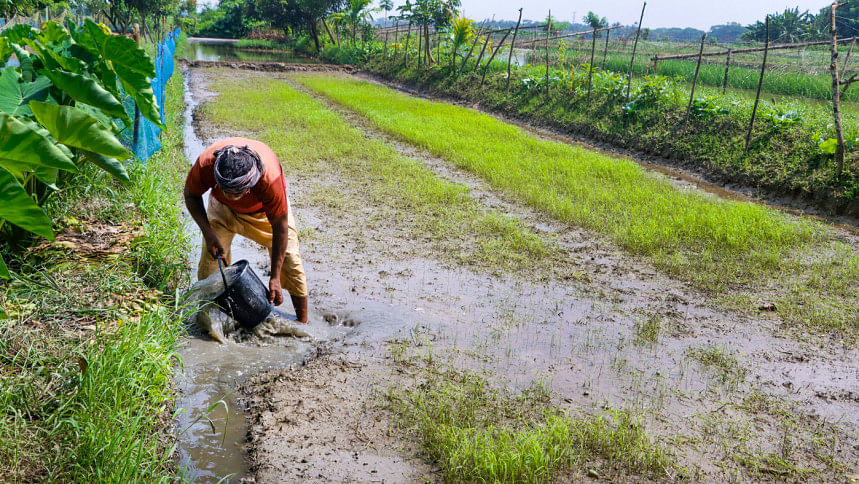Inadequate, faulty sluice gates leave farmlands inundated

A lack of adequate sluice gates and poor maintenance of existing ones are causing widespread waterlogging in Khulna's Batiaghata upazila, significantly affecting Aman paddy cultivation -- the region's only major crop.
Around 40,000 farmers are struggling to manage floodwaters, leading to seedbed damage and the risk of missing this year's cultivation window.
Locals said unless urgent action is taken, thousands of farmers in Polder 30 area and beyond risk losing their main harvest season, placing further strain on livelihoods already battered by climate variability and infrastructural neglect.
The area has over 68 canals and is connected to four active rivers. But there are only 15 sluice gates in the entire area, and just eight of them are currently operational. As a result, floodwaters from the recent heavy rainfall cannot be discharged properly. This has left large portions of agricultural land inundated, causing irreparable damage to paddy seedbeds and even early-winter vegetable fields.

Manoranjan Mondal, former chairman of Batiaghata's Sadar union, said, "Eight functional sluice gates are not enough for Polder 30, which contains 53 beels and 68 canals. Proper water management is impossible. As a result, crop yields have declined dramatically in recent years. Excess rainwater causes flooding, while in the dry season, farmers cannot retain sufficient water for vegetable or watermelon cultivation."
Local farmer Bibhash Mondal from Amtala village in Gangarampur union said Aman paddy is the only dependable crop in the area, but farmers can no longer grow it reliably due to poor water management.
"We live in a saline zone. In the dry season, the local water becomes too salty to use. If the existing sluice gates were functional, we could have allowed sweet water from rivers to enter the canals and stored it for cultivating vegetables and other crops," he said.
Palash Roy, a farmer from Khalashibunia village, said the main sluice gate at Parbatiaghata has been ineffective for years. Several key canals -- Hetalbuniya, Dashkathia, Parbatiaghata, and Patharighata -- remain clogged and unmaintained, affecting over 20 villages.
According to data from the Khulna Agriculture Extension Department, the district received 628 mm of rainfall in July 2025 -- more than triple the 192.37 mm recorded in July 2024. This excessive rainfall has destroyed seedbeds in most beels across the region, especially in Batiaghata and neighbouring upazilas.
Out of 575 hectares of total seedbed area, 106 hectares have been completely damaged, the department reports.
The district's Aman cultivation target is 93,270 hectares, but as of August 2, only about 5 percent has been planted.
Md Nazrul Islam, deputy director of the Agriculture Extension Department in Khulna, said, "Waterlogging is the biggest challenge for farmers here. The limited number of sluice gates, many of which are inoperable, prevents timely drainage of excess water. These gates need to be urgently repaired and more gates must be constructed after consultation with local farmers."

He said major rivers such as the Hari, Hamkura, Salta, Bhadra, and Sholmari should be dredged to address the persistent flooding in the beel areas.
Ashraful Islam, executive engineer of the Khulna Water Development Board, said, "We have informed higher authorities about the need to repair non-functional sluice gates. Many gate mouths are silted up, so simply fixing the gates won't be enough -- we also need proper channels to restore water flow."

 For all latest news, follow The Daily Star's Google News channel.
For all latest news, follow The Daily Star's Google News channel. 



Comments